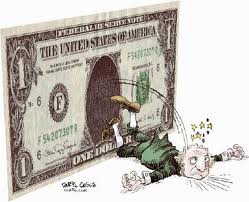In spite of the spending cuts secured in last week’s last-minute budget deal… we are headed for a 50-square-mile iceberg and have just turned the wheel an inch – probably less… [After all,] the $38 billion in cuts represent less than the $54 billion in new debt the U.S. racked up in just the previous week, less than 3% of this year’s projected deficit and less than 1% of what the government has projected to spend in 2011… [In fact, such inadequate action has done nothing more than] reinforce expectations that the U.S. is headed for self-inflicted disaster. [Let me explain.]

So says Perry D. (Percentage of Adults Employed: Heading Back to 26- Year Low) in an article* which Lorimer Wilson, editor of www.munKNEE.com, has further edited ([ ]), abridged (…) and reformatted below for the sake of clarity and brevity to ensure a fast and easy read. Please note that this paragraph must be included in any article re-posting to avoid copyright infringement. Perry goes on to say:
The hollow drama in DC capped a week in which markets continued to abandon the dollar, with the Aussie and Canadian dollars and the Swiss Franc hitting new 52-week highs, gold hitting record highs, the CRB commodity index hitting 2 1/2 year highs, and crude hitting 30-month highs.
Then and Now
During the past 12 months:
1) The dollar has virtually lost safe-haven status. Multiple crises (from Japan’s tsunami to Middle East turmoil) have been accompanied by ominous dollar dumping rather than the kind of crisis-driven dollar-buying we used to see in the past;
2) Bond fund giant PIMCO has gone beyond slashing Treasury holdings and is now actively shorting U.S. debt;
3) The Federal Reserve has become the marginal buyer of most Treasuries offered in auctions over the past year in the growing absence of private-sector or foreign government buyers;
4) Skepticism of the Fed’s inflation-fighting credibility is mounting. A new Rasmussen Reports national telephone survey found 56% of adults were very concerned about the threat of inflation, up from 52% a month ago and 48% at the start [of the year]. Just 14% are not very or not at all concerned. Only 30% were at least somewhat confident in the Federal Reserve Board’s ability to keep inflation under control.
Back in January I wrote regarding the growing risk to the inflation outlook and the dollar’s purchasing power. I observed that the Federal Reserve was, and would be, under the gun in a way it hadn’t been since Paul Volcker headed the Fed through the energy crisis of the late 70′s and early 80′s going on to say that:
- America’s (real) unemployment rate was likely to stay [ at or near] double-digits for some time,
- a bigger permanent American underclass was in the making,
- economic growth would remain poky and government-inflated at best,
- there were no clear signs over the horizon of any significant commitment to improve America’s growth the old fashioned way (i.e. earn it by improving the business climate),
- D.C. was more widely derided than it’s been in decades and
- an historically debt-heavy government would continue to be under ever more pressure to inflate its financial problems away.
Sign up for your FREE weekly “Top 100 Stock Index, Asset Ratio & Economic Indicators in Review”
Today, the risk is actually greater. Back then:
- Paul Volcker had the absolute backing of then-President Ronald Reagan to do what it took to keep inflation under control (including jacking up interest rates into the double digits),
- the U.S. was in a better financial position (a debt-to-GDP ratio of 30% versus today’s roughly 100%)
- Volcker had bigger pro-votes in the Senate than Bernanke appears likely to get and, President Obama’s current support notwithstanding, Bernanke can’t count on that support in the future when political push comes to shove
- President Obama no longer has Reagan-sized level of popularity, and the President’s party — predisposed to putting short-term growth ahead of inflation control and long-term stability during the best of times — can be expected to put more pressure on the Fed to be more loose than it would otherwise be, especially as the 2010 and 2012 elections approach.
In the meantime, amid growing market skepticism over America’s economic management, the federal government’s plan remains: Spend and print as much money as possible until we can’t. “The reality is…,” says economist Peter Schiff said in a recent video , “that there is no will to do anything. Nobody is willing to make any of the cuts necessary to rein in the excesses in Washington.” [Arnold Bock has written an excellent article entitled America’s Political Process Guarantees Another Financial Crisis! which you can read here.]
Future Inflection Points to Self-inflicted Disaster
To read more of this article please go here.
For more articles detailing America’s financial predicament please read the following articles:
- 1. Setting the stage for spiralling inflation
- 2. Is the United States bankrupt?
- 3. Remedies to Fiscal Gap Guarantee Hyperinflation!
- 4. A financial crisis in 2012 is inevitable
- 5. Weiss: A Financial Apocalypse Awaits America!
- 6. Conseqences of country’s debt complacency could be catastrophic
- 7. Washington faces possible Armageddon unlike any since Civil War
- 8. US between a rock and a hard place and it’s options are at best dire
- 9. Hyperinflation to occur in US as early as 2013
- 10.Will this be the USA in 2012?
ATTENTION READERS
We See The World From All Sides and Want YOU To Be Fully InformedIn fact, intentional disinformation is a disgraceful scourge in media today. So to assuage any possible errant incorrect information posted herein, we strongly encourage you to seek corroboration from other non-VT sources before forming an educated opinion.
About VT - Policies & Disclosures - Comment Policy



